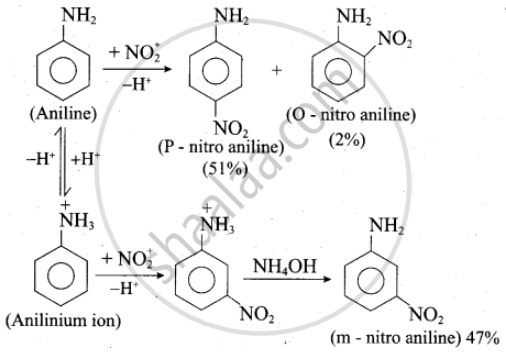Advertisements
Advertisements
प्रश्न
Account for the following.
Although amino group is o- and p-directing in aromatic electrophilic substitution reactions, aniline on nitration gives a substantial amount of m-nitroaniline.
उत्तर
Nitration is usually carried out with a mixture of conc. HNO3 and conc. H2SO4. In the presence of these acids, most of the aniline gets protonated to form an anilinium ion. Therefore, in the presence of acids, the reaction mixture consists of aniline and anilinium ions.
Now –NH2, a group in aniline is O, P-directing and activating while the –NH3 group is anilinium ion is meta-directing and deactivating. Whereas nitration of aniline (due to steric hindrance at o-position) mainly gives p-nitroaniline, the nitration of anilinium ion gives m-nitro aniline. In actual practice, approximately a 1 : 1 mixture of P and m-nitro aniline is formed.

APPEARS IN
संबंधित प्रश्न
In the following

The compound ‘B’ is _______.
(A) Propan–1–amine
(B) Propan–2–amine
(C) Isopropylamine
(D) Dimethylamine
Write a short note on the following.
Mustard oil reaction
Arrange the following.
In decreasing order of basic strength in gas phase (C2H5)NH2, (C2H5)NH, (C2H5)3N and NH3.
Identify A, B and C.
\[\ce{CH3 - NO2 ->[LiAlH4] A ->[2CH3CH2Br] B ->[H2SO4] C}\]
The main product is formed by treating an alkyl or benzyl halide with excess ammonia ____________.
The amine formed from an amide by mean of bromine and alkali has how many number of carbon atoms?
Among the following, which is the strongest base?
Write short notes on the following
Ammonolysis
Write a short note on the following.
Ammonolysis
Write short note on Ammonolysis.
